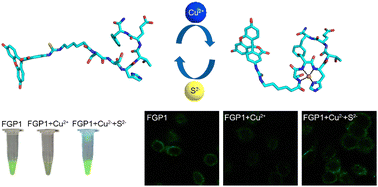A novel “off–on” peptide fluorescent probe for the detection of copper and sulphur ions in living cells†
Abstract
The detection of copper ions and hydrogen sulfide with high sensitivity and selectivity has become a research priority as they play a crucial role in physiopathological processes both in the human body and in the environment. Herein, a fluorescent chemosensor named FGP1 (FITC-Ahx-Ser-Ser-His-Thr-Glu-Phe-NH2) was developed using novel peptides. This chemosensor solely recognizes Cu2+ without any disruption by other metal ions that may compete. The binding of FGP1–Cu leads to the quenching of the FGP1 probe fluorescence with great sensitivity and rapid response time, resulting in a noticeable change of color observable to the naked eye. The association constant of FGP1–Cu is 7.34 × 105 M−1, and thus when S2− is added to the FGP1–Cu complexes, Cu2+ is removed and fluorescence is restored, resulting in an “off–on” process. The fluorescence titration measurements' detection limits, computed utilizing the 3σ/k equation, were 38.2 nM (Cu2+) and 37.9 nM (S2−). These values are considerably lower than the safe levels designated by the US EPA. Furthermore, on account of its favorable water solubility, high biocompatibility and low toxicity, the FGP1 probe proved effective in tracking Cu2+ and S2− in HeLa living cells using the fluorescence imaging technique.



 Please wait while we load your content...
Please wait while we load your content...